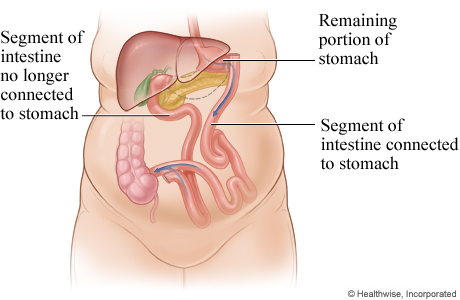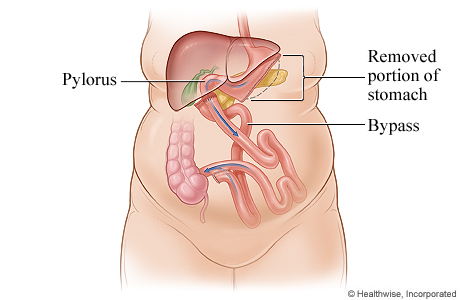Biliopancreatic Diversion

In a biliopancreatic diversion, a portion of the stomach is removed. The remaining portion of the stomach is connected to the lower portion of the small intestine. The food you eat then bypasses much of the small intestine, resulting in fewer calories absorbed and weight loss.
Why is a biliopancreatic diversion with or without a duodenal switch done?
Weight loss surgery is suitable for people who are severely overweight and who have not been able to lose weight with diet, exercise, or medicine.
Most surgeons will not perform duodenal switch surgery unless you are super obese (body mass index (BMI) of 50 or higher) and your weight is causing serious health problems.
It is important to think of this surgery as a tool to help you lose weight. It's not an instant fix. You will still need to eat a healthy diet and get regular exercise. This will help you reach your weight goal and avoid regaining the weight you lose.
Biliopancreatic Diversion With Duodenal Switch

In a biliopancreatic diversion with duodenal switch, a portion of the stomach is removed but the pylorus remains intact. The pylorus controls food drainage from the stomach. The pylorus is connected to a lower segment of the intestine. The upper part of the small intestine (duodenum) is connected to the lower part of the small intestine. The food you eat then bypasses much of the small intestine. This results in fewer calories absorbed and weight loss.
How well does a biliopancreatic diversion with or without a duodenal switch work?
Biliopancreatic diversion surgeries are effective. For people who have a very high BMI, biliopancreatic diversion with duodenal switch provides greater weight loss than gastric bypass. The long-term success is highest in people who are realistic about how much weight they will lose, go to appointments with the medical team, follow the recommended eating plan, and are physically active.
How do you prepare for a biliopancreatic diversion with duodenal switch?
Surgery can be stressful. This information will help you understand what you can expect. And it will help you safely prepare for surgery.
Preparing for surgery
- You may need to follow a clear liquid diet for several days before surgery. Your doctor will tell you how to do this.
- Be sure you have someone to take you home. Anesthesia and pain medicine will make it unsafe for you to drive or get home on your own.
- Understand exactly what surgery is planned, along with the risks, benefits, and other options.
- If you take a medicine that prevents blood clots, your doctor may tell you to stop taking it before your surgery. Or your doctor may tell you to keep taking it. (These medicines include aspirin and other blood thinners.) Make sure that you understand exactly what your doctor wants you to do.
- Tell your doctor ALL the medicines, vitamins, supplements, and herbal remedies you take. Some may increase the risk of problems during your surgery. Your doctor will tell you if you should stop taking any of them before the surgery and how soon to do it.
- Make sure your doctor and the hospital have a copy of your advance directive. If you don’t have one, you may want to prepare one. It lets others know your health care wishes. It’s a good thing to have before any type of surgery or procedure.
How can you care for yourself after biliopancreatic diversion with duodenal switch?
Activity
- Rest when you feel tired. Getting enough sleep will help you recover.
- Try to walk each day. Start by walking a little more than you did the day before. Bit by bit, increase the amount you walk. Walking boosts blood flow and helps prevent pneumonia and constipation.
- Avoid strenuous activities, such as bicycle riding, jogging, weight lifting, or aerobic exercise, until your doctor says it is okay.
- Until your doctor says it is okay, avoid lifting anything that would make you strain. This may include a child, heavy grocery bags and milk containers, a heavy briefcase or backpack, cat litter or dog food bags, or a vacuum cleaner.
- Hold a pillow over your incision when you cough or take deep breaths. This will support your belly and decrease your pain.
- Do breathing exercises at home as instructed by your doctor. This will help prevent pneumonia.
- Ask your doctor when you can drive again.
- You will probably need to take about 2 to 4 weeks off from work. It depends on the type of work you do and how you feel. You will probably return to normal activities within 3 to 5 weeks.
- You may shower, if your doctor okays it. Pat the incision dry. Do not take a bath for the first 2 weeks, or until your doctor tells you it is okay.
- Ask your doctor when it is okay for you to have sex.
Diet
- Your doctor will give you specific instructions about what to eat after the surgery. For the first 2 to 6 weeks, you will need to follow a liquid or soft diet. Bit by bit, you will be able to add solid foods back into your diet.
- Your doctor may recommend that you work with a dietitian to plan healthy meals that give you enough protein, vitamins, and minerals while you are losing weight. Even with a healthy diet, you probably will need to take vitamin and mineral supplements for the rest of your life.
- At first you may feel full after just a few sips of water or other liquid. It is important to try to sip water throughout the day to avoid becoming dehydrated.
- You may notice that your bowel movements are not regular right after your surgery. This is common. Try to avoid constipation and straining with bowel movements. Your doctor may suggest fiber, a stool softener, or a mild laxative.
- Sometimes the stomach empties food into the small intestine too quickly. This is called dumping syndrome. It can cause diarrhea and make you feel faint, shaky, and nauseated. It also can make it hard for your body to get enough nutrition.
- Avoid high-sugar foods—such as desserts, soda pop, and fruit juices—which are most likely to cause dumping syndrome.
- Do not drink liquids within a half hour before eating and up to an hour after eating. Liquids move food even more quickly into the small intestine. Quick emptying of the stomach increases the chance of diarrhea.
- Eat slowly. Try to chew each bite about 20 times. Allow 20 to 30 minutes for each meal.
- Eat 5 or 6 small meals or snacks a day. This may keep you from feeling too full after eating and may reduce problems with diarrhea and dumping syndrome.
- Check with your doctor before drinking alcohol. Your body may absorb alcohol more quickly after surgery.
Medicines
- Your doctor will tell you if and when you can restart your medicines. You will also be given instructions about taking any new medicines.
- If you stopped taking aspirin or some other blood thinner, your doctor will tell you when to start taking it again.
- Take pain medicines exactly as directed.
- If the doctor gave you a prescription medicine for pain, take it as prescribed.
- If you are not taking a prescription pain medicine, ask your doctor if you can take an over-the-counter medicine.
- Do not take two or more pain medicines at the same time unless the doctor told you to. Many pain medicines have acetaminophen, which is Tylenol. Too much acetaminophen (Tylenol) can be harmful.
- If you think your pain medicine is making you sick to your stomach:
- Take your medicine after meals (unless your doctor has told you not to).
- Ask your doctor for a different pain medicine.
- If your doctor prescribed antibiotics, take them as directed. Do not stop taking them just because you feel better. You need to take the full course of antibiotics.
Incision care
- If you have strips of tape on the incision, leave the tape on for a week or until it falls off.
- Wash the area daily with warm, soapy water, and pat it dry. Don't use hydrogen peroxide or alcohol, which can slow healing. You may cover the area with a gauze bandage if it weeps or rubs against clothing. Change the bandage every day.
- Keep the area clean and dry.
©2011-2025 Healthwise, Incorporated
